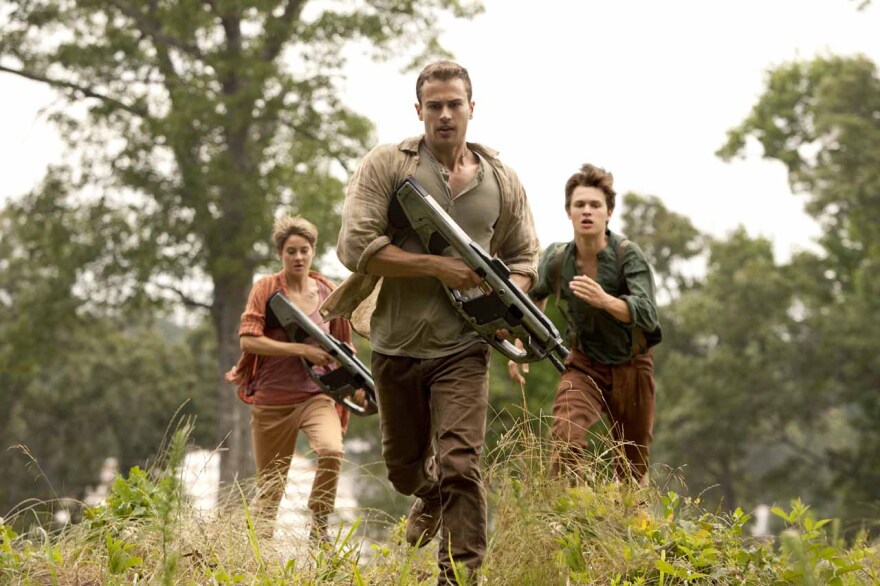A new study reports that there is more violence in PG-13 films than ever — even more than in R-rated movies; you may not recognize Finn Wittrock by name, but you surely know his face from FX's "American Horror Story" to big films such as "The Big Short;" Sarah Megan Thomas is adapting her female-centric film, "Equity," for the small screen.
A disturbing trend: More violence in PG-13 films
A new study from the American Academy of Pediatrics shows that the dramatic increase of gun violence in PG-13 films — a trend noted in earlier research — has not slowed down at all.
Dan Romer, who led the study, is director of the Adolescent Communication Institute at the Annenberg Public Policy Center. In 2013, he found that among top-grossing films, the amount of violence in PG-13 movies had surpassed that of R-rated ones. His recent research shows that trend is gaining momentum.
If anything, it's going up. If you look at the trend, if you graph it, it's just a straight upward trajectory. It seems to be going higher than the R-rated films, with no end in sight. The PG-13 category has gotten increasingly violent and what used to be called R is today called PG-13.
The Frame's John Horn spoke with Romer about the implications of this research for the film rating system and for parents who use it.
Interview Highlights
On the rise of "consequence-less violence" in films:
It shows people being blown away by weapons, but not really being harmed. You don't see any of the suffering. You see no blood. So we worry that maybe a five- or six-year-old watching something like that could get the impression that these kinds of weapons wouldn't really be all that harmful. Now, someone who's older might have a different impression, but these films are open to anybody, with no supervision required. So we worry that it can really send the wrong impression. And we read all the time about kids being exposed to guns and using them.
On the desensitization of parents:
We have a study showing that if you show parents segments of these movies one at a time, after they've watched three or four of these, they begin to think it's not so bad, that one of their own kids could watch such a thing even if they're under 17. So the PG-13 category becomes even more plausible to a parent under these conditions ... The ratings board that the [Motion Picture Association of America] has is supposedly composed of parents, and they have to watch these things, and so we wonder if that doesn't lead to desensitization in the rating system itself.
On the possible relationship between violence on screen and in the real world:
I think it's very troubling. We have a huge gun problem in this country and when it becomes so widespread in the media — in films, television and elsewhere — I think it's very plausible in my mind that, especially if you don't show the consequences, make it look relatively harmless, it becomes more acceptable for people who might have malicious intent. When they watch these films, [they] think, Well, it works for those characters. It'll work for me too.
Editor's note: A spokesman for the MPAA, Chris Ortman, said in a statement that the ratings are evolving constantly: “This system has withstood the test of time because, as American parents’ sensitivities change, so too does the rating system. Elements such as violence, language, drug use, and sexuality are continually re-evaluated through surveys and focus groups to mirror contemporary concern and to better assist parents in making the right family viewing choices.”
'Equity' producer: a show about strong women 'is needed more than ever'
In the wake of the presidential election, the conversation about the representation of women in film and TV has become much more urgent for women in the industry.
Film writer, producer and actor Sarah Megan Thomas had hoped to see Hillary Clinton in the White House, but she isn’t wallowing in disappointment. It’s her mission to show complex female characters — strong, flawed, human — in the hopes of bringing about change.
Her 2016 film, “Equity” — a story about a woman climbing the ladder on Wall Street — was written, produced and directed by an all-female team. Now that movie is being adapted into a TV show for ABC.
Thomas recently sat down with The Frame's host, John Horn.
Interview Highlights
On the timing of her TV series
I think having on TV now a story about three dynamic, ambitious, strong women is needed more than ever — and I think the networks realize that.
On the glass ceiling in entertainment and elsewhere
In many professions, women have not been able to break the glass ceiling — obviously the presidential election, but on Wall Street as well. There's not a female CEO at a major bank ... and so telling these stories about ambitious women in these positions is really important because, hopefully, it can have some influence on young women who see these characters on screen and say, I want to be like that when I grow up.
On the state of the industry
There's a fantastic dialogue in Hollywood right now about having more women behind and in front of the camera, having more female producers, more female storytellers ... For every two men you see speaking on TV, there's one woman. The percentage of female directors is in the low teens, the number of producers is low.




